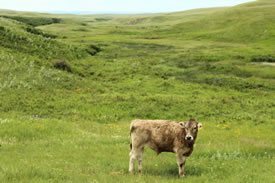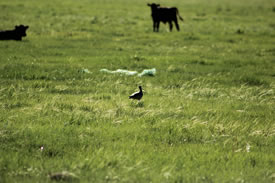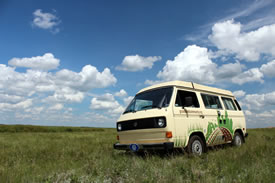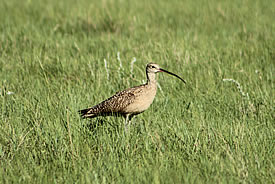Economy vs. ecology: Where do we find the balance in Canada’s grasslands?

Top Grass Beef Ranch, AB (Photo by Mara Erickson)
Comprising only 14 per cent of Alberta’s land base, the Grassland Natural Region is home to a staggering 75 per cent of the province’s species at risk. From burrowing owls to swift foxes to the western spiderwort, populations of grassland species are declining. These declines are not isolated to Alberta, but are seen throughout North America’s vast prairie. Human land use resulting in loss and modification of original landscapes most often takes the blame, but considering the richness of grassland soils and the value they provide to us as a source of food and economic sustenance, it is also no surprise the region is heavily utilized.
How, then, can we balance the needs of society, economy and environment? One human land use in particular — ranching — may offer a solution for the recovery of many endangered prairie species and their habitats. After all, the grassland ecosystem evolved with the presence of grazers when millions of bison once roamed the prairie.
If ranching — an economic venture — might offer us an "environmental" solution, it begs the question: Are grazing strategies that are driven by economics different from those that optimize wildlife habitats?
Unfortunately, it’s not a simple answer.

Long-billed curlew and cattle, Taber, AB (Photo by Mara Erickson)
Tradeoffs
Note: The strategies below are hypothetical extremes, but nonetheless provide a basic picture of the more complex decisions ranchers face when balancing economy and ecology.
Ranching with monetary profit as the sole driver would have detrimental consequences to other aspects of the operation, including the quality of the forage. High-intensity grazing may result in high-weight cattle, but would also lead to a taxed, overgrazed pasture, thus limiting the long-term resiliency of the land. Obviously, ranchers would go out of business fairly quickly if they didn’t pace the grazing capability of their cattle with the capacity of their pastures.
On the other end of the spectrum, managing with wildlife and habitat as the top priority would present its own challenges, as most ecological values are simply not accounted for in the current market system. For instance, re-seeding economically viable cultivated lands back to native prairie may provide ecosystem benefits, but given that the ecological values of native grassland (from carbon sequestration to wildlife habitats) are not accounted for, the lack of return on investment would place ranchers in an impossible financial position.
These examples suggest that ranching strategies for solely economic versus ecological returns are indeed at odds; but that doesn’t have to be the case. It is true that producers generally operate with economic gains in mind — after all, they need to make money to feed themselves, their families and us. However, as they have been on the land for over 100 years and, in many cases, are the reason species at risk are still present, they are clearly paying mind to ecological values.
So, rather than ask if economic gains must come at the expense of ecological gains and vice versa, we should change the focus of our questioning:
- What current, available grazing practices DO optimize habitat for species at risk like the burrowing owl?
- Are any currently in use?
- Are there some that wouldn’t cost anything to implement?
- And for those that do cost money, is money the only barrier to implementation?
This monetary issue prompts its own question: In cases where the financial costs of habitat stewardship outweigh economic gains, who will pay, and how? As we explored in the examples above, ranchers and other land stewards simply cannot afford to be solely responsible for this cost. Given that these ecological goods and services are collectively beneficial, does it not follow that society as a whole must participate in fiscal responsibility regarding land-use practices?
One final question: How?

Conservation caravan (Photo by Mara Erickson)
How do conservation organizations fit in?
There is clearly a need for multi-stakeholder collaboration, beyond the existing working partnerships between ranchers and biologists to include consumers, economists, industry representatives, and government policy makers as well.
There are several organizations that work in the grassland region with conservation strategies in mind; in Alberta, Operation Grassland Community, the Nature Conservancy of Canada, MultiSAR and Cows and Fish are just a few examples. These organizations lend support to this multi-stakeholder collaborative process by highlighting beneficial land practices that double as conservation efforts. For instance, Operation Grassland Community has launched the Conservation Caravan initiative, which seeks to highlight the habitat stewardship of grassland ranchers through film and outreach opportunities.
The Nature Conservancy of Canada is currently promoting and fundraising for the Waldron Project in Alberta — a conservation agreement that, in partnership with the Waldron Grazing Co-operative Ltd, relies on grazing as part of the conservation strategy.
These groups also have the opportunity to educate the public about practices that, due to market failures, are ecologically beneficial but not currently economically feasible. And with the ever-increasing consumer demand for sustainable food production, it is essential that the public is aware of their consumer role in supporting grassland stewardship potential.

Long-billed curlew, Taber, AB (Photo by Mara Erickson)
Ranching has significant capacity to sustain our endangered grassland ecosystem. However, it’s up to all of us to recognize the stewardship strategies producers currently implement while understanding our own role in supporting the continuation and enhancement of those practices. This is a story with huge potential for balanced outcomes. We may not have all of the answers up front, but we can certainly start by asking the right questions.


